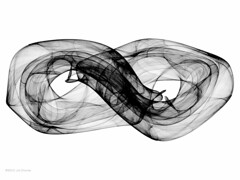Philosophers have long loved grappling with paradoxes — paradox-grappling is like no other exercise for the intellect. Perhaps the most famous paradox of all — Zeno’s Paradox — actually has a lesson in it, even for those of us who don’t usually grapple with such things.
Zeno’s Paradox
Here is how Zeno’s paradox goes: the speedy Achilles is chasing a much slower tortoise who has had a head start. Common sense tells us that if Achilles is running faster than the tortoise, he will overtake his shelled opponent in some finite amount of time. However, if you look at the situation slightly differently, a potentially troubling picture emerges. Say that Achilles runs half the distance between himself and the tortoise; in the time it takes him to run that distance, the tortoise has moved ahead slightly. Achilles, being a trooper, runs half that new distance, still trying to catch the tortoise; but in the time it takes him to run half this smaller distance, the tortoise has moved ahead again, ever so slightly. If you repeat this thought experiment ad infinitum, you are logically bound to conclude that Achilles can never actually catch up to (let alone overtake) the tortoise. This conflicts with our common sense notion (which happens to be correct) that Achilles will indeed, in short order, catch and overtake the tortoise. Thus the paradox.
Solutions
There are many solutions to the paradox, most of which draw on notions from mathematics: e.g., you might, if you are mathematically inclined, notice that the halving of distances about which we were just waxing leads to an infinite geometric series that converges to a finite sum. In plainer English: the infinite halving of these distances does not itself add up to an infinite distance; that is, we can add all the tinier and tinier distances we like, but we will not be making Achilles’ task impossible, because all he has to do is cover a small finite distance. In even more concrete terms: One of Achilles’ strides measures something like, say, three feet. Once Achilles is less than three feet away from the tortoise, it doesn’t really matter if he is supposed to cover some theoretical infinity of tiny intervals — he covers all that and more with one real-world stride.
The Lesson
What’s the lesson here? Well, for one thing, we have to be wary of counting mathematical abstractions as real. But that’s a topic for a different blog. The other, more relevant lesson is that sometimes tiny steps are not enough. Sometimes one needs to make big strides in order to cover ground and make headway.
Renowned philosopher of science Thomas Kuhn came to the same conclusion regarding scientific progress. In his seminal The Structure of Scientific Revolutions, he posited that there are two basic modes of scientific research: so-called “normal” science, wherein scientists are doing research under the guidance of certain theoretical constructs; and “revolutionary” science, wherein the theoretical constructs themselves are changed in periods of great upheaval. While important strides can be made during periods of normal science (Kuhn calls the work being done here “puzzle solving”), sometimes the only way to get to the next great step is by, like our intrepid Achilles, running over an infinitude of tiny, normal steps, and doing something big. In science, this “something big” is often quite revolutionary, in an almost literal sense: revolutionary scientific thinkers, like Einstein, step outside of the systems in which they are working and design a new system that furnishes normal scientists with a new framework in which to solve new puzzles. But these new puzzles wouldn’t get done if there were not a great revolutionary there to redefine what counts as normal.
Between Achilles and Einstein
Achilles was lucky — all he had to do was run, and the physics of strides took care of providing him with the tools to tackle the paradoxes of the infinite. Somewhere in between Achilles and Einstein lies a path for the rest of us to occasionally do something big and shake things up. The next project on which you’re working, if you feel like you’re just making marginal progress and that that progress won’t get you to somewhere useful… well, maybe you’re right. Maybe you need to revolutionize your work.
Design Implications
As a designer, sometimes this revolutionary step is as simple as starting from scratch. I’ve been caught up in designs that were going nowhere, and no amount of incremental changes would have saved them. The only thing to do in such a case is to abandon these designs — which, I know, is incredibly difficult. Every design I produce, I tell myself, has a germ of beauty in it somewhere, and will do the work I need it to do, if only I can figure out how. Unfortunately, sometimes the way to do this is by abandoning it and trying something completely different. The ruts we get ourselves into can be good aids to productivity; but they can also be powerful traps that keep us from doing something original.



